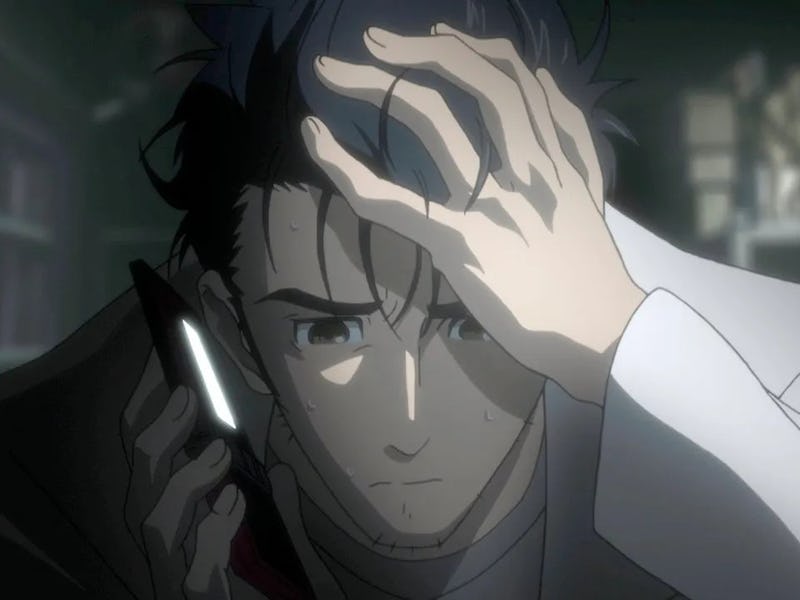13 years later, the most cerebral time-travel game ever made still holds up
A deadly mind game.

Video games have explored time travel for decades now, from the mind-bending mechanics of Majora’s Mask to the eerily static shootouts of Quantum Break. While the gimmick often makes for a memorable experience, very few stories examine the mental and emotional impacts that traveling through time might have on a person. That’s exactly where Steins;Gate comes in, with a phenomenal story that puts the humanity of its main character at the center of all its timey-wimey shenanigans.
While the award-winning anime of Steins;Gate has been more widely embraced, the series is actually based on a visual novel of the same name, first released in Japan back in 2009. The two share the same story, but the anime condenses and elevates the presentation of the original interactive experience. The game was developed by 5pb (now known as Mages Inc.), a studio with a long history of other notable visual novels like Chaos;Head, Corpse Party, and Robotics;Notes.
Steins;Gate focuses on Rintaro Okabe, a self-proclaimed “mad scientist” that runs the Future Gadget Laboratory out of his one-bedroom apartment. Despite his brilliance, Okabe is a social reject who’s failed to find success in life — until he accidentally stumbles upon the secret to time travel.
THE RULES OF TIME TRAVEL is an Inverse special issue exploring the evolution of science fiction's most imaginative sub-genre. From Marty McFly to Avengers: Endgame.
Steins Gate’s characters feel like anime stereotypes at first, but the story quickly subverts those tropes.
Through a wild experiment using bananas and a microwave, Okabe figures out a way to send text messages into the past, thus influencing his past self and the timeline. He uses this newfound power to save a brilliant scientist name Makise Kurisu, and things spiral completely out of control from there as the group discovers a way to send someone’s consciousness back in time.
“Even the most innocuous interactions become major plot points.”
What’s so fascinating about Steins;Gate is that it’s truly a story about time travel, not just a story that features time travel. The story is a slow burn that builds up to a thrilling climax before completely pulling the rug out from players with a wild endgame twist. As Okabe uses his D-Mail (Delorean Mail) to influence the past, things start becoming more thorny, as complications he could never have predicted begin to spring up like so many hydra’s heads.
Without wading too much into spoilerville, by changing the past and altering the timeline, Okabe creates a line of causality that all but guarantees the demise of someone he loves. From there, much of Steins;Gate’s story is a desperate dash through time, as Okabe repeatedly attempts to prevent this horrible inevitability. As the story slowly unfolds, so too does Okabe’s psyche, as he’s subjected to seeing his friend perish over and over. Before long, Okabe can’t remember what he’s changed and what’s true to the original timeline, and his grasp on reality grows more and more shaky.
Steins Gate is pretty light on gameplay, with only a few interactive elements in terms of choices and using Okabe’s phone.
Steins;Gate is filled with fascinating characters, but Okabe is at the heart of everything. Both the game and show masterfully balance humor and tension, taking the audience on a rollercoaster of emotions. One second you’re laughing at Okabe’s strange obsession with Dr. Pepper, and the next you’re witnessing government conspiracies and horrific crimes. Time travel is, of course, central to the story, but it’s more of a vessel for unpacking the eccentricities of the main cast and helping them confront the trauma they’ve faced.
“One of the best time-travel stories ever told.”
Most time travel stories come with their own fair share of plotholes — it’s a natural side effect of the genre. But Steins;Gate manages to tie everything together better than most. The level of thought and care put into the story are startling, and a steady trickle of revelations means even the most innocuous interactions become major plot points.
A sequel called Steins Gate 0 was released in 2015, and also has an anime adaption. The story follows one of the worldlines created when Okabe changed the past.
As a visual novel, Steins;Gate is light on gameplay, as most of your time is spent reading and solving some light puzzles. The game features a wealth of choices that can alter how the story plays out, which is obviously a contrast to the mainline story told by the anime. The gameplay experience is really just a vessel to tell the story, and luckily there are multiple ways to experience Steins Gate, depending on what gels with you the most.
Both the original game and anime are fantastic, but if you want something that falls in the middle you can play Steins;Gate Elite, which replaces the hand-drawn scenes of the original game with fully-animated versions from the anime.
Steins;Gate is the rare experience that questions why we’re so obsessed with time travel and changing the past. Most people say they would change the past if they could, but what effect would that really have on you as a person, and the reality you see? This is an utterly engrossing story about the nature of the human mind, and one of the best time-travel stories ever told.
The original Steins;Gate is available for purchase on PC, Xbox 360, PS3, and PS4. The Steins;Gate Elite remake is available for purchase on PS4, Switch, PC, and Vita.